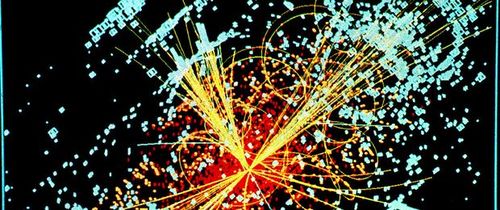A first glimpse of the elusive Higgs
On 13th December, Physicists at the CERN institute in Geneva reported that they had seen the first ‘tantalising hints’ of the Higgs boson. The elusive particle has been given the nickname ‘the God particle’ due to its purported property of providing the universe with its mass. The current theory states that everything we call ‘empty space’ is filled with Higgs particles, we then get a Higgs field which other particles interact with to varying degrees.
The Higgs field can be thought of as a universal treacle – if you pull an object through the treacle, it will gain mass as it gathers treacle. Similarly, if a particle travels through (and interacts with) the Higgs field, it will gain energy. The more energy it gains, the more massive it becomes and hence particles have mass.
The main experiment responsible for these results is known as ATLAS, a project that many of Warwick’s own professors and research fellows are involved in. ATLAS was originally proposed in 1994, and has been running since 2008. All of the experiments at the Large Hadron Collider (LHC) were built to study, improve and extend the standard model of particle physics.
The standard model has been continually developed throughout the 20th and 21st century – it is currently the best model we have to describe how our world works. Contained within the standard model are three of the four fundamental forces: electromagnetism, the weak force and the strong force. Only gravity is left out.
The standard model also explains how different fundamental particles interact with one another, and also predicted the existence of copies of particles that make up ordinary matter. These have since been discovered through the use of particle accelerators like the LHC. Although most of the predictions from the standard model have been experimentally confirmed, the obvious exception is the Higgs boson, which has been theorised since the 1960s but has not yet been observed. The ATLAS experiment has provided a small amount of evidence supporting the existence of the Higgs, but it has not yet been discovered.
So if CERN hasn’t actually ‘discovered’ the Higgs boson, what has it found? Well, essentially it has found the first piece of the puzzle. Although the standard model didn’t predict the mass of the Higgs, it was possible to calculate that the particle should be in the energy range 115-180 gigaelectronvolts (GeV). ATLAS has provided evidence that there are an excess of events in this magic region, more specifically at 124-125 GeV, (about 130 proton masses).
The standard model didn’t predict the Out of millions of proton-proton collisions; only 3 possible Higgs events occurred but this was enough to set the scientific community alight with excitement. The spike in the data caused by the excess of events at the 124-126 GeV region is just above the so called ‘two sigma’ level of uncertainty – meaning that they are only slightly greater than two standard deviations away from what is expected.
In simpler terms, there is roughly a 1% chance that this happened due to random fluctuations. This isn’t nearly enough to classify a discovery – a spike above the ‘five sigma’ level is required to classify a discovery of the Higgs Boson, or indeed any discovery in particle physics. This would mean that there is less than a one in a million chance of these events happening by accident.
So when can we expect a more definitive answer as to the existence of the Higgs? Well, as with all experimental physics, nothing is ever certain. As for reaching the five sigma level, if the Higgs particle does indeed exist, we can expect to reach the accuracy required for a ‘discovery’ in roughly a year. Fingers crossed 2012 will bring with it the biggest scientific breakthrough this century.

Comments